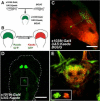Genetic and optical targeting of neural circuits and behavior--zebrafish in the spotlight
- PMID: 19781935
- PMCID: PMC2787859
- DOI: 10.1016/j.conb.2009.08.001
Genetic and optical targeting of neural circuits and behavior--zebrafish in the spotlight
Abstract
Methods to label neurons and to monitor their activity with genetically encoded fluorescent reporters have been a staple of neuroscience research for several years. The recent introduction of photoswitchable ion channels and pumps, such as channelrhodopsin (ChR2), halorhodopsin (NpHR), and light-gated glutamate receptor (LiGluR), is enabling remote optical manipulation of neuronal activity. The translucent brains of zebrafish offer superior experimental conditions for optogenetic approaches in vivo. Enhancer and gene trapping approaches have generated hundreds of Gal4 driver lines in which the expression of UAS-linked effectors can be targeted to subpopulations of neurons. Local photoactivation of genetically targeted LiGluR, ChR2, or NpHR has uncovered novel functions for specific areas and cell types in zebrafish behavior. Because the manipulation is restricted to times and places where genetics (cell types) and optics (beams of light) intersect, this method affords excellent resolving power for the functional analysis of neural circuitry.
Figures




References
-
- Asakawa K, Kawakami K. Targeted gene expression by the Gal4-UAS system in zebrafish. Dev Growth Differ. 2008;50(6):391–9. - PubMed
-
- Scott EK. The Gal4/UAS toolbox in zebrafish: new approaches for defining behavioral circuits. J Neurochem. 2009;110(2):441–56. - PubMed
-
- Gong S, et al. A gene expression atlas of the central nervous system based on bacterial artificial chromosomes. Nature. 2003;425(6961):917–25. - PubMed
-
- Kawakami K, et al. A transposon-mediated gene trap approach identifies developmentally regulated genes in zebrafish. Dev Cell. 2004;7(1):133–44. - PubMed
Publication types
MeSH terms
Grants and funding
LinkOut - more resources
Full Text Sources
Other Literature Sources

